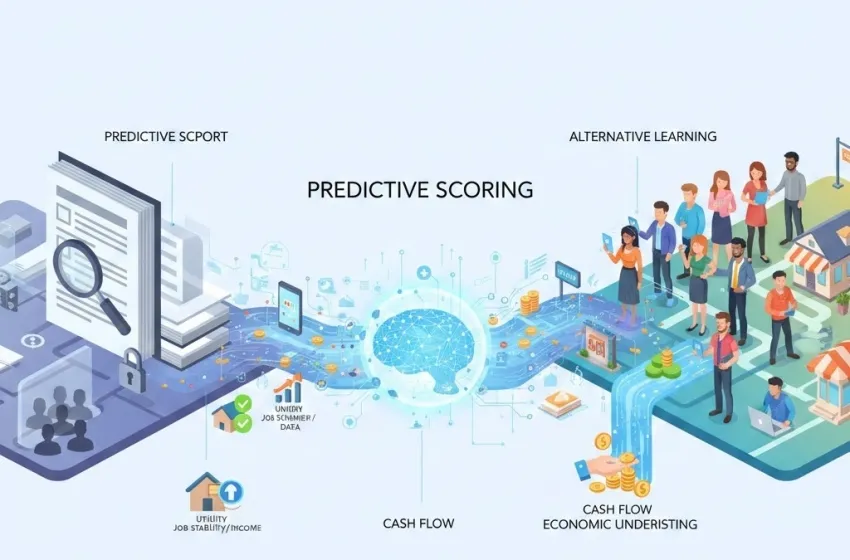Discover how predictive credit scoring uses Machine Learning & alternative data like utility payments for cash flow underwriting
Predictive Analytics in Credit Scoring is undergoing a profound transformation, moving beyond static, historical data to leverage the power of advanced technology and non-traditional insights. This shift is not merely a technical upgrade; it is a fundamental re-imagining of how creditworthiness is assessed, with significant implications for global **financial inclusion**. By utilizing sophisticated **machine learning** algorithms, lenders can now analyze vast, diverse datasets—including previously overlooked digital footprints—to create more accurate, dynamic, and fair credit risk models. This paradigm shift is critically important for the world's **underbanked** population, who are often excluded from traditional financial services simply because they lack a formal credit history.
The Limitations of Traditional Credit Scoring
Traditional credit scoring models, such as the widely recognized FICO system, rely predominantly on five core components: payment history, amounts owed, length of credit history, new credit, and credit mix. While effective for individuals with long, established credit profiles, these models inherently exclude or penalize vast segments of the population.
- **"Credit Invisibles":** Individuals with no credit file, such as young adults, recent immigrants, or those who prefer to deal only in cash.
- **"Thin-File" Consumers:** Those with insufficient credit information to generate a reliable score, often due to minimal use of traditional credit products like credit cards or mortgages.
- **Bias Perpetuation:** Traditional models can inadvertently perpetuate historical biases by prioritizing the type of financial behavior common in already-served demographics, overlooking responsible financial habits in underbanked communities.
The inability of these legacy systems to assess risk accurately for these groups results in a significant financial exclusion gap, limiting access to affordable loans, mortgages, and other vital financial products necessary for economic mobility.
Predictive Credit Scoring and Machine Learning
**Predictive credit scoring** is a data-driven approach that uses statistical modeling and **machine learning** (ML) to forecast an individual's likelihood of default or delinquency. Unlike traditional models that are rule-based and static, ML algorithms can analyze thousands of variables simultaneously, identifying complex, non-linear patterns that human analysts or simple linear models would miss.
The Role of Machine Learning
**Machine learning** algorithms, including Random Forests, Gradient Boosting Machines, and Neural Networks, are the computational engine behind this revolution. They are trained on large, diverse datasets to learn the correlation between various data points and future loan repayment success. The key advantages of using ML are:
- **Increased Accuracy:** ML models provide a more nuanced risk assessment by dynamically weighing the importance of various factors, leading to better prediction of default rates.
- **Handling Big Data:** They can process and make sense of massive volumes of both structured and unstructured data, which is essential for integrating **alternative data**.
- **Real-time Decisioning:** ML-powered models can evaluate loan applications and generate a score in seconds, facilitating instant loan approvals and improving the customer experience.
- **Continuous Improvement:** The models are designed to learn and adapt over time, continuously refining their predictions as new data and performance outcomes are fed back into the system.
The Power of Alternative Data
The integration of **alternative data** is the most significant differentiator of next-generation **predictive credit scoring**. This refers to non-traditional data points that reflect an individual's financial stability and responsibility but are not included in a standard credit report. For the **underbanked**, these data points are often the only evidence of their responsible financial behavior.
Unlocking Creditworthiness for the Underbanked
The use of non-traditional data, combined with ML, provides a more holistic and equitable view of creditworthiness for populations historically excluded from mainstream finance. Here is how various types of **alternative data** are being used:
| Alternative Data Source | Example Data Points | Creditworthiness Signal |
|---|---|---|
| **Utility Payments** | Consistent, on-time payments for electricity, water, gas, and internet bills. | Demonstrates **payment discipline** and consistent **cash flow** management. |
| **Job Stability & Income** | Paycheck direct deposit frequency, length of employment at current job, and income volatility (especially for gig workers). | Confirms reliable income streams and employment commitment. |
| **Online Behavior / Digital Footprint** | Mobile phone usage (top-up frequency, contract stability), e-commerce transaction history, types of apps installed. | Can indicate financial sophistication, reliability, and consumption habits. |
| **Rental History** | Verified, on-time rent payments to landlords or property management companies. | The single largest monthly expense for many, showing fundamental ability to manage debt-like obligations. |
| **Education/Professional Data** | Educational attainment, professional certifications. | Proxy for future earning potential and stability. |
By analyzing patterns of timely payments for essentials like rent and utilities, the ML models can confirm financial reliability for an individual who has never had a credit card. A stable mobile phone contract or a consistent pattern of digital money transfers can be a robust predictor of their likelihood to repay a loan, effectively creating an accurate alternative credit score.
Cash Flow Underwriting: A New Standard
The rise of **alternative data** is inextricably linked to **cash flow underwriting**. This method shifts the focus from an individual's *credit history* (a backward-looking measure) to their *current ability to pay* (a forward-looking, real-time measure).
**Cash flow underwriting** involves the direct analysis of a borrower's bank account transactions (with their explicit permission) to understand their actual income, expenses, and savings patterns.
Key Insights from Cash Flow Data:
- **Verified Income:** Directly verifies the frequency, source, and consistency of income, which is particularly useful for gig-economy workers, freelancers, and small business owners who may not have a standard monthly salary slip.
- **Debt Service Coverage:** Measures the borrower's excess cash after covering essential living expenses and existing debt payments, giving a clear picture of their remaining capacity to handle a new loan payment.
- **Expense Analysis:** Identifies financial habits, such as excessive Non-Sufficient Funds (NSF) fees or consistent spending beyond income, which serve as early warning signals for financial stress, or conversely, positive indicators like regular savings deposits.
This approach provides a much more granular and realistic assessment of repayment capacity, enabling lenders to offer tailored loan products and appropriate loan terms, significantly increasing access for the **underbanked** while responsibly managing risk.
Incorporating Behavioral Finance
While the application of ML and alternative data addresses the data gap, the principles of **behavioral finance** address the psychological gap in risk assessment. **Behavioral finance** studies how psychological biases influence economic decisions.
Traditional finance assumes borrowers are rational, but **behavioral finance** acknowledges that human financial decisions are often influenced by cognitive biases such as:
- **Present Bias:** The tendency to overvalue immediate rewards and undervalue future ones (e.g., delaying repayment to spend money now).
- **Loss Aversion:** The psychological pain of a loss is twice as powerful as the pleasure of an equivalent gain, which can be leveraged to encourage timely payments.
Behavioral Insights in Scoring
**Predictive credit scoring** models can integrate behavioral variables derived from digital footprints and transaction data to anticipate a borrower's future actions:
- **Repayment Consistency:** Analyzing the *timing* of payments—paying on the due date versus paying several days early—can indicate a level of financial mindfulness and conscientiousness that is highly **predictive**.
- **Digital Engagement:** High engagement with financial management or budgeting apps can signal a proactive attitude toward personal **finance**.
- **Spending Patterns:** Sudden, unexplained spikes in non-essential discretionary spending could indicate financial instability or a lack of self-control, offering a real-time risk signal.
By incorporating these behavioral features, ML models can achieve greater accuracy, moving beyond a simple "credit score" to a comprehensive "behavioral risk profile."
Driving Financial Inclusion
The ultimate promise of **predictive credit scoring** is to achieve true **financial inclusion**. This means making useful and affordable financial products and services accessible to individuals and businesses previously excluded.
The Impact on Underserved Communities:
- **Democratization of Credit:** By using **alternative data** and **machine learning**, millions of credit-invisible individuals can now obtain their first loan, creating a formal credit history and a path to greater economic opportunity. This is a game-changer for underserved communities, rural populations, and gig-economy workers worldwide.
- **Fairer Risk-Based Pricing:** More accurate risk assessment means lenders can offer better interest rates and fairer terms. Instead of being lumped into a high-risk category simply because they lack a credit history, responsible but underbanked individuals can receive a personalized, lower rate commensurate with their actual risk.
- **Economic Empowerment:** Access to credit is a crucial tool for starting a small business, paying for education, or weathering an economic shock. By opening the door to responsible credit, **predictive credit scoring** fuels local economies and empowers individual economic growth.
The convergence of **machine learning**, **alternative data**, and **cash flow underwriting** is not just an incremental improvement in lending; it is an algorithmic pathway to building a more equitable and financially inclusive global economy. However, this advancement must be managed responsibly, with careful attention to data privacy, model explainability (avoiding the "black box" problem), and ensuring the models do not inadvertently introduce new forms of algorithmic bias. The future of lending rests on this intelligent, data-driven balance.





























